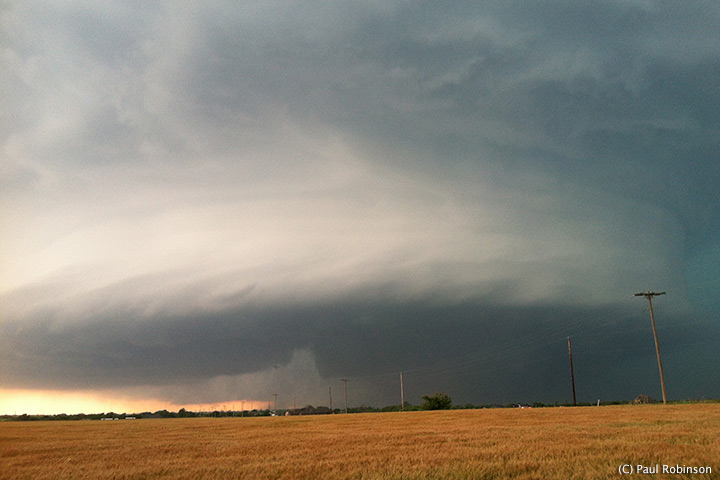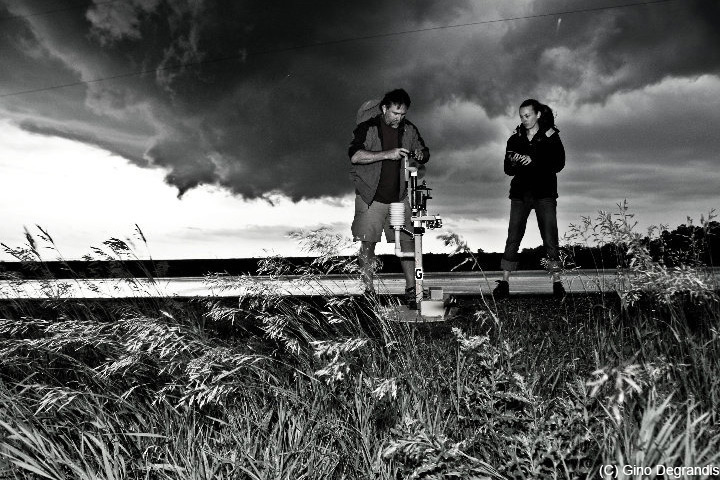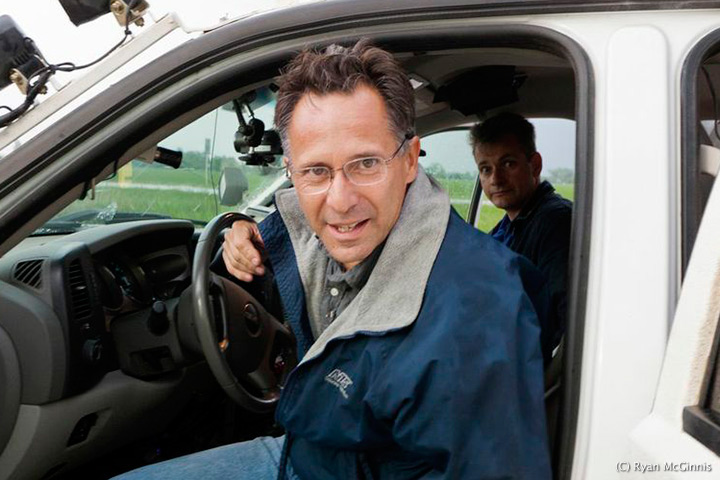The following is a guest post from Erin Jones (pictured above), the scientific outreach lead for the Global Modeling and Assimilation Office at Goddard Space Flight Center. As a graduate student at Purdue University, she used to chase tornadoes.
June 2, 2013, started as most Sundays do. My alarm went off; I got out of bed; I came downstairs, and I turned on my computer. I logged on to facebook. A quick look at my news feed told me that this Sunday would not be the same as most Sundays:
Getting lots of rumors that veteran chasers were killed by the El Reno tornado. I really hope this is not real.
… just received the news of the possible passing of Tim, Carl and Paul. We are in total shock… God rest their souls if this is true.
Hopes that messages about Tim Samaras are not true… Bad news if this is true…
I put my hand to my chest.
“No.”
The rumors were true. Tim Samaras, his son Paul, and his chase partner Carl Young were gone. They had been killed while chasing a storm on May 31 near El Reno, Oklahoma, when a large tornado hit their car and reduced it to scrap metal.
I was in shock.

The storm that produced the El Reno tornado, as seen from the vantage point of mobile Doppler radar DOW8, near Mustang, OK. Photo courtesy of Paul Robinson.
The sad truth of the matter is that many in the community have thought for years that it was only a matter of time before a storm chaser was killed. Since the practice of storm chasing began over 50 years ago, not a single chaser had died in pursuit of a storm. Over the past several years, however, increased media coverage and TV shows like Storm Chasers have glamorized chasing and spurred the growth of an entire industry built around following storms.
The number of chasers has exploded, and it has made chasing for science more difficult and dangerous. I’ve seen it. I’ve felt what it’s like to be on a storm, just hoping that the circulation getting ready to pass over your head stays aloft because you’re stuck in chaser-induced gridlock and there’s no way you’d be able to escape if a tornado forms. I’ve known that fear. It’s like we have been on borrowed time.
As much as I dreaded the day when I would hear that a tornado had killed a storm chaser, I thought I was prepared for it. But nothing could have prepared me for what I heard on Sunday morning. Tim Samaras—a pillar of the chase community—was dead. He was a well-respected, veteran chaser. He wasn’t out for the thrill, and he wasn’t out to get the best picture or to take some extreme video. He was a serious scientist. And he was gone.
Why? How?
These questions have been at the forefront of the minds of many of my friends and colleagues over the past few days. As people begin to piece together accounts of what happened…as they process and analyze the data that were collected during the storm, a clearer picture is beginning to emerge. The tornado that hit near El Reno was more than 2.5 miles wide, making it the widest tornado ever recorded. It had a multiple vortex structure with wind speeds of up to 296 miles per hour. Toward the end of its life, it became occluded and turned northeast, deviating from its forecast path.
Tim Samaras and his crew had always chased safely. They knew what they were doing but it didn’t matter. Had they been caught off guard? Had they ended up stuck in traffic? Were they driving on unpaved roads that were difficult to navigate in storm conditions? Was the tornadic circulation so large that it was impossible for them to get to safety? We still don’t know.
Many of my friends were out there that day. By chance or circumstance, they all stationed themselves out of harm’s way. Three of them–Paul Robinson, Eddie Smith, and Jon Lutz–were several kilometers away from the tornado, collecting mobile Doppler radar data on the storm when it hit Tim Samaras. I asked them if they had any thoughts or stories they’d like to share about what happened.
“I’m not sure what to contribute,” Eddie said. “At the same time Paul, Jon, and I were high-fiving each other over our great positioning and the phenomenal data set we were recording, we were watching, in real-time, this thing kill our friends. How do you reconcile that?”
Jon reflected that “that thing could have killed any of us, depending on which way it turned.”
And Paul told me how he was struck by a sense of eerie irony when they ended up in Moore, Oklahoma, after fleeing the storm, where they then witnessed an EF-0 tornado disturb the same landscape that an EF-5 tornado had devastated just two weeks before.
We still don’t have a great understanding of how tornadoes form, and we still don’t know much about what the wind fields are like near the ground. Tim Samaras spent his career trying to answer these questions so that the losses due to tornadic storms might be minimized. When Tim left this world, his work was not done. It would be a disgrace to his memory if we were to stop trying to collect scientific data on severe storms and to retard the progress on tornado research that he so diligently strove for.

During a chase on May 19, 2010, Jones’ team had to abort operations because heavy traffic made their attempts to collect data unsafe. Credit: Erin Jones.





